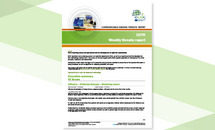ECDC Communicable disease threats report, Week 32, 3-9 August 2014
he ECDC communicable disease threats report is a weekly bulletin intended for epidemiologistsand health professionals in the area of communicable disease prevention and control. Summarising information gatheredby ECDC through its epidemic intelligence activities regarding communicable disease threats of concern to the European Union,it also provides updates on the global situation and changes in the epidemiology of communicable diseases with potential to affect Europe, including diseases that are the focus of eradication efforts.
Executive Summary
The ECDC Communicable Disease Threats Report (CDTR) is a weekly bulletin intended for epidemiologists and health professionals in the area of communicable disease prevention and control. This issue covers the period from 3 to 9 August 2014 and includes updates on:
West Nile virus, transmission season in Europe
During the past week, no new human cases of West Nile fever were reported in the EU or in neighbouring countries. West Nile fever in humans is a notifiable disease in the EU. The implementation of control measures is considered important for ensuring blood safety by the national health authorities when human cases of West Nile fever occur.
Outbreak of Ebola Virus Disease (EVD) in West Africa
Since the last CDTR, the affected countries reported 388 additional cases including 203 new fatalities. On 8 August 2014, the outbreak was declared a public health emergency of international concern (PHEIC) by the World Health Organization.
The EVD outbreak has been affecting Guinea, Liberia and Sierra Leone since December 2013. While this is the largest EVD outbreak ever reported, the risk of infection for travellers is considered very low. ECDC published a risk assessment on 4 August and an epidemiological update on 08 August.
Middle East respiratory syndrome-coronavirus (MERS-CoV)
During the past week, no new cases were reported. Since the beginning of the outbreak in April 2012, 853 cases of MERS-CoV infection have been reported by local health authorities worldwide, including 331 deaths. ECDC published its updated rapid risk assessment on MERS-CoV on 31 May 2014 and an epidemiological update on 5 June 2014.
Chikungunya in the Caribbean
Compared to last week, the number of reported cases of chikungunya infections has risen by 8% in the affected areas. The Dominican Republic accounted for the highest increase, with more then 26 000 new cases reported. An outbreak of chikungunya virus infection has been ongoing in the Caribbean since December 2013, and has spread to North, Central and South America. There have been more than 510 000 probable and confirmed cases in the region, including 32 fatalities. ECDC published a risk assessment on 25 June and an epidemiological update on 30 June.
Download






